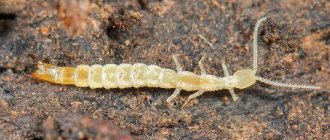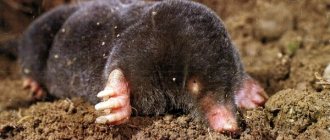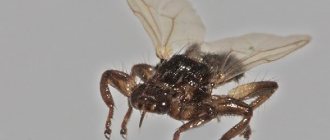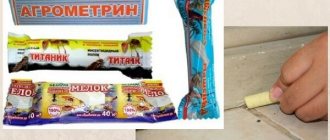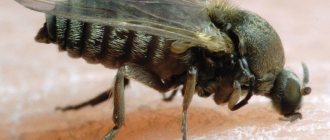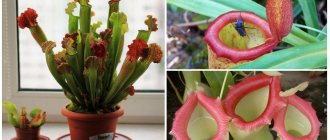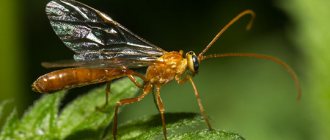What does it look like
Those who know what a moose louse looks like can better protect themselves from such an insect.
This parasite has various names: deer fly, moose tick, moose bloodsucker. These insects are very similar to ordinary fleas and ticks, so they are often confused with each other. The moose louse has the following structure :
- The size of the light brown body reaches 2-5 mm. It is equipped with paws with claws that allow the insect to cling to animal fur.
- The parasite has wings (5-6 mm long), which it rarely uses for its intended purpose. Having found a new owner, the louse sheds its wings and burrows into the animal’s fur.
- The head of a louse is equipped with a proboscis, through which the insect draws in blood. The parasite also has 2 compound eyes, occupying a quarter of the head, and 3 ordinary ocelli.
Elk lice have male and female individuals. After fertilization, the female carries an egg, from which a pupa and larva will eventually develop. After 16-18 days, the adult gives birth to a larva (prepupa, the size of which is 3-4 mm), which transforms after 2 hours into a puparium. The birth of a new pupa occurs after 2-3 days. During its life, a female moose louse gives birth to 20-30 larvae.
Throughout its short life, a louse parasitizes on one host, but if it dies, the insect is forced to move to another. Every day the louse makes up to 18 meals. At one time it sucks up to 1 ml of blood. If there are too many such individuals on an animal (from 200 to 1000), then it may experience severe blood loss, become exhausted and die.
The structure of the mouthparts of an elk tick
Insects have a piercing-sucking type of mouthparts. It resembles the proboscis of an autumn burner fly. So, there are chitinous growths on the proboscis. They are sharp enough to scrape off the skin in the area where the parasite plans to attach itself. Then the bloodsucker begins to drink blood.
Chitinous growths
resemble small teeth, which allows you to achieve the desired result - quickly disrupt the integrity of the outer integument.
Reproduction
After reaching sexual maturity, moose lice split into pairs, and the process of fertilization and procreation begins. Once on the animal’s body, the female gets the opportunity to give birth to larvae. Just give birth. The eggs develop inside, after some time they pupate and are born as small bugs.
After a few hours, the chitinous cover of the larvae hardens, and the insect falls to the ground. Externally, the moose louse at this life stage resembles a flea. A tiny body with 3 limbs.
The larva exists in the soil cover for about 5 months. At the last stage of development, long wings appear. Insects climb onto grass, bushes, and low trees. Victims are constantly waiting there.
The sense of smell is acutely developed. Animals are heard by smell. As it approaches, they take their starting position and fly onto the body. Within a few hours they are fully settled and receive the first portion of blood. The eggs begin to develop. After 2 weeks, the first larva appears in the moose lice.
On a note!
The moose louse lives on the animal's body for six months. During this time, 30 larvae are born. But they are parasitic, drinking blood only from imagoes.
Moose lice in the photo in the larval stage are shown below.
Life cycle
Females give birth to several larvae that are ripe for pupation, one at a time at significant intervals (they develop in the female’s abdomen in a uterine-shaped expansion of the oviduct, into which a pair of glands that secrete a nutritious secretion opens). At the end of August - beginning of September, the larvae mature. By this time, the young individuals have wings.
Like all representatives of the family Hippoboscidae, this species has viviparity, or puppethood, in which the development of the egg and larvae takes place in the mother’s body, and large (3–4 mm) prepupae are born, which, without undergoing any external change in shape, darken and harden, turning into puparia, which can only complete pupal metamorphosis. At a time, the female fly lays only one prepupa, after which the next one enters the vacated uterus and begins to mature. The first prepupae, or puparia, are born in the second half of September, and their regular laying continues throughout the entire period of parasitism of flies. The hardened shell of the puparia is black, smooth and does not attach to the fur in any way. Puparia fall to the ground, and prepupae, hatched from October to March, begin to develop only with the onset of warm weather (14...16 °C). Pupa development continues until August. Thus, at the end of summer, adult winged flies appear - descendants of the bloodsuckers that emerged last year. Hatching of winged deer bloodsuckers in central Russia is extended and occurs from mid-August to mid-October. Despite the fact that flies have fairly large wings, they do not fly very well, so they lie in wait for their prey, sitting on the grass, branches of bushes or trees.
Moose flies attack only during the day. Both males and females feed on blood. Seeing a suitable object, the bloodsucker takes off and moves towards the potential owner. Bloodsuckers fly poorly and not far, they fly towards warmth and smell. Once on the body of a host, for example an elk, the bloodsuckers shed their wings, breaking them off at the base, burrow into the fur and begin feeding on blood. Within two to three weeks after the start of feeding, the period of maturation of flies begins (the color of the integument darkens, the head is retracted into the shoulder outgrowths of the chest, the wing muscles atrophy, the size of the abdomen increases, sexual dimorphism appears and sexual activity is observed). One elk, deer or cow can be parasitized by up to 1000 or more flies. On average, there are 200–300 deer bloodsuckers on one elk or cow. The hatching of the first puparium by the female occurs 16–19 days after copulation, that is, approximately a month after the flight of the winged individual. Subsequent puparia are laid after two to three days. Under optimal conditions, one female can lay from 20 to 30 puparia during her life, which then fall from the host’s fur to the ground. The hatching of prepupae begins at the end of September and continues until the end of March, since the bloodsuckers that live in the fur of the warm-blooded host live for a very long time and are active throughout the winter. Hunters and lovers of winter walks in the forest have the opportunity to watch how tits feast on high-calorie food, collecting fallen puparia from the snow at moose feeding and bedding areas. The lifespan of the wingless parasitic form of the deer bloodsucker on the host’s body is five to six months, and only by the beginning of summer do moose become completely free of bloodsuckers. The bloodsuckers that parasitize the host are divided into pairs. Males are firmly attached to females, so wingless individuals are usually found in pairs (male - female).
Morphology and developmental biology
Lipoptena cervi also has other names: deer bloodsucker, moose fly, moose tick.
Winged insect, gray-brown in color, up to 7 mm long. The oral apparatus is a piercing-sucking proboscis. The proboscis is usually retracted into the head, except when feeding. Compound eyes are 2 times longer than wide. 3 longitudinal veins are visible on the wings.
The body of the insect is dorsoventrally flattened. Ticks have a soft, leathery abdomen with poorly defined segmentation. Claws on the paws allow them to hold firmly on the fur or plumage. By mechanically piercing an animal's skin, lice can be carriers of blood parasites.
The lurking bloodsucker attacks from trees within a radius of 50 m. It sheds its wings onto the animal’s body. It feeds on blood for 5-7 days, after which copulation (mating) occurs. In 2-3 months, the female is capable of giving birth to up to 30 prepupae, which, covered with a hardened larval shell (puparium), then turn into pupae. The pupae fall into the soil, where after 86-160 days they turn into young winged bloodsuckers. By the end of September the first puparia appear.
For the development of the insect, a warm temperature is required - up to +16ºC.
The attack on animals begins at the end of July and continues until the onset of stable frosts. The largest number of bloodsuckers on moose is observed from October to February.
Up to 1 thousand bloodsucker parasitize an adult moose. Most flies are found in the neck, back and sides.
From February to July, the population of deer bloodsuckers decreases. In July, the animals completely get rid of last year's flies. But with the onset of swimming time, when animals, fleeing from midges, are completely immersed in the reservoir, the number of insects increases.
The moose louse feeds 15-20 times a day, sucking 0.3 mg of blood. Males feed less frequently than mature females. Lice parasitizing on an adult elk in numbers from 3 to 5 thousand are capable of sucking up to 50 g of blood, which leads to exhaustion of the animal. Animals are forced to stand in ponds for a long time to escape flies and scratch themselves on trees. Because of this, they develop extensive dermatitis, complicated by microflora. Infection of animals with elk lice provokes the disease lipoptenosis.
Description and characteristics of moose lice
Like all parasitic insects, the deer bloodsucker first flies up or jumps up to the victim, then tightly attaches itself to the hairs and breaks off its wings, changing its lifestyle to a sedentary one (Figure 1).
Among its victims may be deer, elk, horses, cows and even bears.
A moose fly, entangled in the long fur of an animal, is similar to a tick. After shedding its wings, you will see its translucent oval red-brown body and tenacious legs, like a tick. The elk fly measures approximately 3 mm in length. With wings this mark reaches 6 mm.
Figure 1. These blood-sucking insects prefer to live in bushes and tall grass
Walking through the summer steppe or warm forest glades, you can see what an elk tick looks like - it’s practically a flat-bodied fly that will persistently try to land on your skin.
Other names for blood suckers: moose fly, moose louse, moose tick
The insect can be easily confused with different parasites, so you should study its description:
- color – brown (usually light);
- the body is covered with shiny leathery coverings;
- the insect has 2 wings;
- the body is flat, divided into several sections;
- there are 3 pairs of legs, they are quite thick (especially in the hips);
- the length of the parasite is small - up to 3.5 mm;
- there are eyes: 1 pair of fairly large complex organs of vision, in addition there are 3 simple eyes;
- eats claws on limbs;
- the oral apparatus is of the spiny-sucking type, like most insects, it is distinguished by its small size;
- the antennae are on the head, but they are hardly noticeable, since they are located in the recesses on the forehead.
Due to its small size, apparent absence of antennae, flat body and the presence of wings, the parasite looks like a fly, similar to a tick. Thus, there are a number of similar external signs of the deer bloodsucker with other pests:
- the presence of 3 pairs of legs and wings makes the parasite look like a fly, but they have a significant difference - a different body color, flies are black, green, but brown insects of this species are not found, so the bloodsucker can be easily distinguished if you know about this feature;
- flat body, small size allows the pest to be mistaken for a tick, among representatives of both families there are brown individuals, but if you look closely, you will notice that ticks have 4 pairs of legs, and the bloodsucker has only 3 pairs of limbs, it is noted that the moose flea can increase in size after eating during the breeding season, this makes it look like a tick;
- The small length of the body and light brown color make it possible to mistake the bloodsucker for a louse; it really looks like a head parasite, but lice do not have wings, which makes it possible to distinguish pests from each other.
Interesting:
When an elk tick attaches itself to a host, it soon sheds its wings; it is this factor that makes the pest similar to other parasites (ticks, louse), since they cannot fly.
Why is the deer bloodsucker dangerous for animals?
In large quantities, moose ticks systematically drink the blood of animals, as a result they become restless, stop sleeping and eating normally, as a result of which exhaustion occurs, and the growth of young animals slows down. In addition, regular blood loss can lead to their death.
The deer bloodsucker can be found on the body of the following animals:
- roe deer, deer, elk, deer - representatives of the family of artiodactyl mammals;
- cattle;
- wild boars, bears, dogs, foxes, badgers, goats, sheep and others - their parasitism was noted.
Insects drink the blood of animals about 15–20 times a day. Sexually mature females feed more often than males. When it comes to pets, it is impossible to specifically prevent the appearance of parasites. A person can save them from the long-term presence of deer bloodsuckers using special aerosols and sprays to kill insects such as flies, mosquitoes, and ticks.
The damage caused by the deer bloodsucker
The damage caused by deer bloodsuckers is very noticeable, especially on young animals. The bite of an elk louse in itself is unpleasant, but if a whole swarm of them attacks, then the animal, firstly, loses a lot of blood. Secondly, it cannot sleep or eat peacefully. As a result, a fawn or young elk becomes weak and inattentive, and ceases to develop physically; it is these animals that are the prey of the “forest orderlies” of wolves.
People protect domestic animals from wolves, but they suffer from deer bloodsucker bites no less than wild animals. The special sprays with which they are treated, of course, help make life easier for animals, but are not a panacea.
Deer bloodsucker on hand photo
Parasitism on humans
Despite rare cases of transmission of infectious diseases by parasites and predictably developing symptoms after infection, the question of interaction with bloodsuckers remains open.
The elk tick is capable of attacking not alone, but with a “team”; the total swarm can be up to 120 individuals. The larger the prey appears to the insect, the more likely it is to land on it. For this reason, children on the street or at home will most likely not be affected by elk ticks.
As soon as the insect hits the skin, it waits 5-10 seconds (sometimes several minutes), after which it goes to the hair or under clothing. Whatever the type of skin a person has, the elk tick will leave consequences on the epidermis in any case. People with high sensitivity or thin skin feel the bite very painfully; people with a higher pain threshold may not even notice the first day. The pain is accompanied by a strong burning sensation, complemented by itching and instant redness. However, a full bite mark may only appear after a few days (Figure 4).
Figure 4. The bite of this parasite is extremely dangerous for humans
According to research, elk lice can leave four types of marks on humans:
- Fleeting - a mild rash with a crust, disappears in 4-5 days.
- Medium - the appearance of a tubercle with a crust, disappears in 10-12 days.
- Severe - the appearance of blisters and redness within a radius of 10-15 centimeters from the lesion, which resolve within 1 month.
- Extremely severe - development of hippoboscosis, dermatitis, erythema, the treatment of which will take up to six months.
Consequences of a bite for a person
A moose louse bite leads to the development of dermatitis.
Four types of dermatitis of varying severity have been identified:
- After the bite, a maculopapular rash appears, which disappears after 5-6 days without consequences.
- Rash of itchy papules that resolves within 2 weeks.
- Papular urticaria is the appearance of small blisters.
- There is no reaction from the body to the first bite of a bloodsucker. With subsequent bites, acute inflammatory exudative blisters develop, the treatment of which lasts up to six months.
With a repeated bite, an allergic reaction, local or systemic, may develop, since insect allergens persist for a long time in the human blood.
When bitten by a deer bloodsucker, a person experiences:
- itching, hyperemia after 5-10 minutes;
- rash formation after 5-12 hours;
- at the site of the rash, after 20-25 hours, vesicles with serous contents form;
- transformation of vesicles into pustules, from which yellow liquid oozes for 5-15 days;
- As the liquid is released and dries, brown crusts form.
After the crusts are rejected, dark spots remain on the skin that do not resolve for more than 1 month.
It is easy to treat parasite bites at home. The surface of the skin is treated with hydrogen peroxide. An antipruritic agent, which includes menthol, camphor, and kelamine, is applied to the bite sites.
Papules should not be scratched. In this case, a secondary infection may occur. Your doctor will tell you which antibiotics to take at your clinic appointment.
The consequences of numerous bites can be mistaken for lice or another skin disease.
The body's reaction to bloodsucker bites is individual. It is believed that people who constantly go into the forest and are often attacked by lice react to bites more and more sharply over time.
It has been found that bloodsuckers are most active when the weather is humid.
When attacking, moose flies are guided by the size and color of the victim. Having good eyesight, they notice moving figures of people or animals. The one walking in front is attacked by a larger number of bloodsuckers. If there is a child in the group, the lice may not notice him.
They prefer dark gray and dark brown clothing colors. They will ignore a jacket made of synthetic slippery fabric. Clothing made of natural, loose materials that you can cling to with your claws attracts them to a greater extent.
Hunters have noticed that moose lice prefer the scalp, especially the back of the head. They immediately shed their wings and begin to feed, piercing the skin with a strong proboscis. A moose fly that has shed its wings and has a flat body becomes like a tick.
Despite the fact that the causative agents of Lyme disease were found in a quarter of the bloodsuckers studied, medical statistics do not confirm the fact that they carry infectious diseases. This is facilitated by the bloodsucker’s lifestyle. It parasitizes all its life on one host, unlike ticks, which use several victims for feeding, including natural reservoirs of infectious diseases - rodents.
Are they dangerous for humans?
Some are concerned about whether elk lice are dangerous to humans. This insect bites, but the development of pediculosis after a bite is impossible. Such a louse can cause serious harm to forest animals and livestock, but it does not pose a great danger to humans. Most often, foresters, mushroom pickers or hunters complain about the bites of such insects.
The moose louse bites quite painfully, and then at the site of the bite, hyperemia, induration, and unbearable itching appear. A person can scratch himself until scratches appear on the skin. Moose lice are not carriers of infection. But through the wounds at the bite sites, a secondary infection can occur. In addition, a bite can provoke the development of an acute allergic reaction.
What to do if parasites attack?
How to get rid of deer lice if you couldn’t protect yourself from them and they still attacked? From the stories of many eyewitnesses and victims, it can be understood that moose fleas crawl under clothing and can even penetrate and cling to hair, making them difficult to get out. They also have strong chitinous shells, so they cannot be crushed immediately.
If you find deer fleas on yourself, don't panic. Remove and thoroughly dry all your clothing. And it’s better to do this not immediately, but upon arriving home, since if you undress in the forest, you will even more attract various insects, including real fleas or ticks. All things need to be actively shaken out. And since moose flies have tenacious legs, you can use a vacuum cleaner to remove them from the surface of the material. Next, wash the clothes thoroughly in hot water, steam them with an iron or steam generator (you can replace this procedure with regular ironing) and dry them, and then shake them off again to remove any surviving moose fleas.
You can remove deer lice from your body with water. Take a shower or hot bath. If you find parasites in your hair, wash it thoroughly and comb it with a comb or comb with frequently spaced teeth. If necessary, ask someone for help, since it is difficult to detect and remove all the insects on your own, especially if there are a lot of them.
If the number of deer fleas found in clothing or on the body is large, then use specialized insecticidal preparations used to combat other insects - parasites. These can be various sprays, solutions or emulsions. There is no product specifically designed to kill deer bloodsuckers.
How to treat a bite
Moose lice bites may involve the insect latching onto the skin.
If this happens, you can remove it as follows::
- A loop is made from a strong thread, which is tightened on the body of the louse. The parasite is pulled out by twisting and swinging the thread.
- Another method of extraction is using tweezers. But in this case, special care should be taken so as not to partially tear off the body of the louse and leave the other half under the skin.
- You can apply sunflower oil to the moose louse. After a quarter of an hour she should come out on her own.
At home, it is impossible to eliminate all the consequences of contact with an insect in 1 day, but if you consult a dermatologist who will tell you how to treat bites, then recovery will not take long.
After removing the insect, the wound should be treated with an antiseptic: hydrogen peroxide, chlorhexidine digluconate. You should refrain from scratching the bitten area. To reduce itching, you can apply ice, aloe tincture or calendula to eliminate the inflammatory process. In case of a severe allergic reaction, it is recommended to take an antihistamine.
How to treat the affected area
If you find moose lice bites on your body, do not panic under any circumstances. Even if you are an insectophobe or believe that after a bite you are guaranteed to develop an extremely severe form of inflammation, proper treatment will allow you to avoid consequences.
It is ideal if you feel good about your body and can remove moose lice directly while feeding them.
It will be almost impossible to remove the thin flat body of the insect with your fingers, and if you do, its cephalothorax will remain in your skin, which will aggravate the situation. An ordinary thread will come to the rescue: tighten a loop near the insect’s head and begin to unwind and swing the thread so that the sting itself slips out of the skin. It’s even better if you have a first aid kit (or manicure set) with tweezers with you, then you can eliminate the insect in a few seconds.
And the simplest way we use to fight ticks is to lubricate the skin with oil and roll the body. Immediately after this, it is necessary to disinfect the affected area, if the wound channel is large - try to squeeze out the poison and clean the skin as much as possible (Figure 5).
If you don’t have a first aid kit or wet wipes with antiseptic at hand, you can use:
- Using matches to cauterize a wound:
at first glance, this is an outdated barbaric method, but if done correctly, you will not get burned, but will only cauterize the edges of the wound. - Celandine juice:
Celandine is a ubiquitous weed with bright yellow flowers that have bright orange juice inside the stem. After cutting or tearing the stem, apply a few drops to the wound. You will feel a burning sensation, as when using iodine - the wound will be disinfected.
Remember that if itching occurs later, you should never touch the wound. In order not to tempt yourself, try to put on an adhesive plaster at first. When you realize too late that a bloodsucker has bitten you, the elk tick bite still needs to be treated. Also, do not forget about antihistamines such as Mebhydrolin, Diazolin, Loratadine, which block allergies due to parasite venom.
How to remove moose ticks, treatment
The bloodsucker, in terms of severity of removal from the skin, is similar to ordinary ticks. Here are some removal methods.
- Thread. They make a tiny loop, tighten the lice under the abdomen, swinging it in different directions, and remove the insect. The thread must be strong.
- With tweezers. Be careful not to crush the parasite in half, otherwise part of it will remain inside the skin.
- Sunflower oil. Lubricate the parasite with oil and wait for it to come out on its own (about a quarter of an hour).
Parasite protection
How to protect yourself from moose fleas or lice? These insects react to heat and the smell of sweat, so you need to choose suitable clothing. When going into the forest, it is best to wear a specialized protective suit that will reliably cover all parts of the body. It should be made of thick fabric and have cuffs on the sleeves and legs, as well as a collar that fits tightly to the neck. In this case, fleas simply will not have access to the skin. In addition, they will not detect the smell of sweat or heat, so they will not regard humans as a potential food source. And to protect the most exposed part of the body, which is the head, from parasites, you can wear a mosquito net. This accessory is indispensable when walking in the forest in the summer.
Specialized repellents will also help provide protection against moose fleas. But eyewitnesses say that not all of them effectively repel deer bloodsuckers, so you need to choose only powerful drugs with a sharp, noticeable odor and a high concentration of active substances. Taiga or Deta sprays are suitable. You should treat all your clothes so that the parasites smell it before reaching the person and cannot get on his skin.
Remedies for protecting moose lice in the forest
An elk louse can only get on a person by accident. Human blood is not suitable for the bloodsucker; by feeding on it, the parasite stops producing offspring.
When going to the forest in the warm season, you need to choose clothes that will hide your body as much as possible, because an insect can get under your clothes or onto your hair. The use of special means – repellents – will help protect against insects. They need to treat all clothing and open areas of the body. Parasites must smell an unpleasant odor. Therefore, repellents should be chosen with a strong, persistent odor and a high content of active ingredients. Any mosquito repellent will be suitable for these purposes. For lasting results, treatment is carried out every 3-4 hours.
When you come home from the forest, you should carefully examine your clothes and body for the presence of insects. Afterwards, comb your hair with a fine-toothed comb.
There is no need to worry that an elk louse accidentally brought into the house will take root, since the parasite will not be able to exist in a living room.
There may be cases of detection of bloodsuckers in dacha and garden plots located near forest belts. For protection, trees and bushes should be thoroughly treated with insecticides, and tall grass should be mowed if possible. An effective remedy in the fight against moose lice is to plant plants on a plot of land that can repel them. Such plants include common wormwood and tansy. The bloodsucker does not tolerate moisture, so you should spray the lawn and trees more often. Some gardeners recommend adding alcohol or garlic juice to the water.
Benefits and harms
All types of blowflies pose an epidemiological danger to humans because they live on decaying organic matter and corpses. They eat there too. They are mechanical carriers of pathogenic microorganisms - bacteria, viruses, parasites. The most dangerous disease is leprosy, the most common is intestinal infection.
The blowfly does a lot of harm to fishing by laying eggs or larvae in lightly salted, fresh fish. The product loses its presentation and poses a threat to human health and life.
On the body of animals where there are open wounds, females lay eggs and reproduce larvae. Attracts the smell of rotting flesh and bacteria on damaged skin. Worms make passages in living flesh, feed, and lead an active lifestyle.
We suggest you read: What are small flies in the kitchen called?
Along with this, the blowfly or carrion fly is extremely beneficial, helping to decompose corpses. This cleans the environment.
blowfly
Prevention
To protect yourself from deer fleas, you need to follow the following preventive measures:
- You should not visit the forest during the period when insects are active, which usually occurs at the end of summer and beginning of autumn.
- Choose suitable clothing. It should be as closed as possible and made of dense fabrics.
- Use repellent before going into the forest. Use them not only on skin, but also on clothes and accessories.
- It has been proven that deer fleas can attack humans only during daylight hours, since they are to a certain extent guided by vision when choosing a victim. Therefore, if you avoid walking in the forest during the day, you can protect yourself from parasites.
- Hunters are at particular risk. Cases of mass attacks on humans are often recorded during the cutting of artiodactyl animal carcasses, so it is advisable to be fully armed during such a procedure. To do this, put on a mosquito net, protective suit and gloves in advance.
Now if you encounter deer fleas, you will know how to get rid of them. But it’s better to worry about protection in advance and follow preventive measures.
Are moose flies dangerous to humans?
Moose fly on a person's finger
Moose ticks attack not only animals, but also people, usually in forests, during daylight hours and in calm weather. Often there is a massive attack of parasites on a person, their number can reach up to 120 pieces. in one minute.
Apparently, when choosing an object, the deer bloodsucker is guided by the size of the target, since it has been observed that it attacks children under eight years of age much less often than adults. Moose people are most attractive to moose flies.
When an insect lands on a person, it sits motionless for the first few seconds, and then begins to quickly move around the body, mainly trying to get under clothes or into hair. It will not be possible to get rid of the parasite even with sudden movements.
How to protect yourself from moose lice?
When the parasite sees a person, it moves over his clothing to the scalp, clinging to the material with its paws. Therefore, one of the main ways to protect against deer bloodsucker is a headdress and clothing covering the entire body. Clothing should be comfortable for movement and at the same time closed. A jumpsuit would be a great choice. Pants must be tucked into shoes or socks.
Before a walk in the forest, you can wash your hands and face with tar soap, and treat your clothes with special protective agents against parasites.
After going into the forest, you must carefully inspect all clothing and all belongings for the presence of moose ticks. Be sure to inspect the entire body and check for bites.
Industrial control methods
In areas with large deer bloodsucker colonies, protective measures must be taken to prevent the parasites from moving into human homes. To treat gardens and vegetable gardens, you can purchase special products that need to be used to spray your garden plots. Today, a very large number of different chemicals are produced.
When choosing a product, it is important to check whether it is safe for animals, people, and vegetation. Spraying gaseous chemicals on household plots allows you to treat even the most difficult to reach places, while leaving no chance for insects to survive.
To kill deer bloodsuckers indoors, it is recommended to use carbon dioxide. In the liquid state, the temperature of this substance is -50C. This product can be sprayed onto various surfaces. As a result of the treatment, not only moose flies will leave the room, but also other insects.
Folk methods of struggle
To prevent the accumulation of parasites in private areas, it is recommended to regularly mow the grass. After all, deer bloodsuckers prefer to live on tall plants. The deer bloodsucker does not like high moisture. For this reason, it is necessary to spray trees, shrubs and lawns with water, and frequent watering can help control the insect. You can add garlic or alcohol to the water. In addition, tansy and wormwood are considered effective in the fight against parasites.
Moose louse is not dangerous to human life. No cases of infection after its bites have been identified. However, livestock should be protected and protected from this parasite.
How to cure a moose tick bite?
The moose fly bites quite painfully. On the skin, the bite sites may swell, turn red, and small bloody spots may remain. In some cases, in addition to these symptoms, there may be itching. To remove it, you can use calendula tincture, ice, soda paste or aloe juice. Also used for this purpose are remedies for flea bites and ointments for various insect bites, for example, Zvezdochka balm.
If you have allergies, medications and ointments should be prescribed by a doctor. You should not self-medicate, as this may worsen the situation.
Question-answer section
To avoid collisions with moose parasites, it is necessary to learn more about the peculiarities of their life activity. All questions can be asked to an entomologist on the website online.
How is it different from a real tick?
Alisa, 34 years old, Rostov-on-Don. “The main difference is the wings of the moose bloodsucker. But if she has already attacked you or an animal, then the wings are shed. You can count the legs – a true tick has 8 of them. In addition, the limbs themselves of arachnids are thin and shorter.”
There is a moose flea in my hair, what to do, how to get rid of it?
Olga, 38 years old, Vladimir “When an elk tick attacks, it is somehow easier to notice and remove it on the skin. How do you remove it from your hair?” “The principle is the same: use tweezers or thread, in this case you need to ask one of your relatives to do it. It is necessary to open the area first so that the hair does not interfere.”
How to identify a moose flea bite?
Vera, 36 years old, Moscow. “Externally, I can, in principle, distinguish the bloodsucker-elk tick. How can you recognize its bite? “The main difference is the formation of a papule at the point of skin puncture. In addition, immediately upon being bitten there is pain (but not in all people) and a burning sensation.”
Deer bloodsucker in the apartment! Is it possible?
Vera, 35 years old, Kirov. “I often find blood-sucking pests in my apartment. How do they get there if they live mainly on animals in the forest and households?” “It’s very simple - parasites attack birds, so they spread quickly. Sometimes such pests are brought home on clothes. I hope you manage to get rid of them."
Deer bloodsucker in the apartment: how to get rid of it
Moose ticks usually live in nature, since this is where most of the animals they feed are located, however, sometimes they can be found in an apartment or private house. Most often this happens if there is a park, forest, large-scale natural recreation area or nature reserve near your home. The likelihood of moose ticks increases significantly if there are stables or enclosures with mammals in these places.
If you have a deer bloodsucker in your apartment, how to get rid of it you can choose from two options, which are essentially one, just in different designs. We are talking about poisoning parasites with chemicals. This can be done either independently or with the help of SES. In the latter case, you need to order the service of treating the entire apartment from insects, and the problem with bloodsuckers will be solved in just 1 day if you contacted a SES certified by Rospotrebnadzor with many years of experience.
You can try to treat your apartment from parasites yourself using products for exterminating crawling and flying pests with a wide spectrum of action, for example, such as:
- Raid or Raid Max aerosol
- Raptor universal protection against 17 types of insects
- Tsipromal
- Lambda Zone
- Gett
- Xulat
- Contra Insect
- Combat MultiSpray, PowerSpray or SuperSpray
- Medilis Super
- Aerosol Delicia
Bloodsuckers not only crawl and fly around your house, but also directly attack your body and health, so the sooner you get rid of them, the better. It makes no sense to devote time to useless attempts to deal with them using folk or other non-chemical methods, since they will scare off the parasites only for a while, without completely solving the problem.
Popular questions
Many people are new to this insect, so they have many questions.:
- Where is moose louse most common? Most often, this parasite makes itself felt in Siberia, the European part of the Russian Federation, China and Scandinavia.
- How long is the life cycle of an insect? The maximum elk louse lives is 5-6 months. It usually dies in the spring, after an active breeding period.
- What animals can it live on? Animal feeders for moose lice can be: moose, deer, and deer. They are also found in the fur of smaller animals (bears, foxes, wild boars). Most often, such pests settle on wild animals, but sometimes they can also be found on livestock (goats, cows, sheep).
The moose louse usually attacks fairly large, moving people, and it does not perceive children or stationary people as victims. Once on the human body, the moose louse first freezes and then begins to move quickly. Quite painful bites can be felt almost immediately. But some people hardly notice them. It all depends on the individual characteristics of the body.
If a person has been attacked by elk lice and has discovered such parasites on himself, then he should quickly get rid of them.
After the extraction procedures, the victim must bathe and wash his hair thoroughly, as well as wash his clothes. It is also advisable to use antiparasitic agents based on insecticides, and if complications develop, consult a dermatologist.
Reproduction and lifestyle of the bloodsucker
Despite its large wings, the insect practically does not fly, so it prefers to wait for prey on low trees or bushes, and more often on the grass, where elk or deer feed daily, from where it jumps onto their fur. They have well-developed heat and odor sensors, so their increased attention can be attracted during a picnic.
The period of maximum activity of the species falls from the end of August to the end of October; during these months the parasite manages to produce offspring. The species has viviparity, therefore female deer bloodsuckers bear and lay one puparia at a time - the last stage before pupal metamorphosis (Figure 2).
Puparia are not attached to the fur, so they fall to the ground, where they lie until the first warmth of spring. Gradually they begin to develop until they reach full maturity. Then the cycle ends and new bloodsuckers fly in search of victims. On average, one female lays several dozen prepupae throughout her life, if the conditions for her reproduction and gestation were suitable.
Figure 2. The parasite poses a danger not only to animals, but also to humans.
Bloodsuckers live on animals for up to six months, after which they are replaced by younger individuals. A moose tick bite is very painful, takes a long time to heal, and abscesses and redness may form around the wound. Looking through the skin of an animal after bites, you can see large tubercles with subcutaneous hemorrhage. On average, the bite stays on the body for 15 to 20 days.
It is difficult to answer unequivocally the question of whether an elk louse is dangerous to humans or not, since the danger comes from the consequences of a bite - a possible abscess in the field if the wound gets infected, suppuration, severe itching and pain, and allergies. Also, some individual individuals (up to 28% according to studies of the second half of the last century) can be carriers of Lyme disease.
